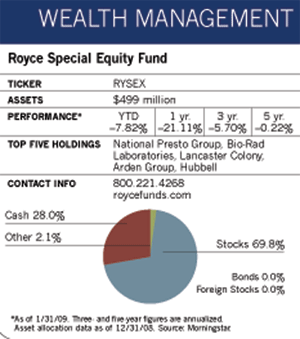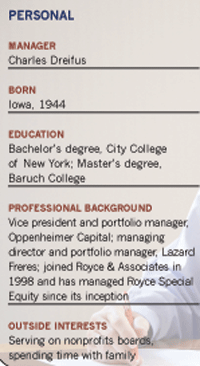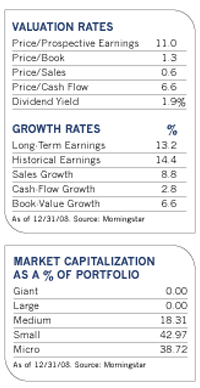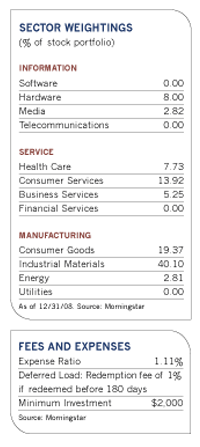That observation is borne out by the fund's bottom-decile finish among its small-cap value peers between 2003 and 2005, as well as its strong showing in 2007 and 2008. "This fund is not for people looking for big home runs, but for those who want a quiet and conservative way to enhance their capital," says its manager, who is all too familiar with performance-driven asset inflows and outflows. At the height of its popularity in 2004, it had nearly $1.5 billion in assets. At the beginning of 2009, it was about one-third that size.
Investors can credit at least part of the fund's relatively good performance last year to its lack of financial services and natural resource stocks, which were two of the worst-performing sectors at the time. At the end of September 30, the fund had 3% of its assets in the former group and 3.6% in the latter. The fund's avoidance of last year's market quagmires was a reflection more of the managers' long-standing investment preference than a prescient call, according to Dreifus, who says that he has always been skeptical of how analysts can arrive at precise earnings figures for financial services companies when there are so many variables involved, such as fluctuating interest rates, indeterminate loan quality and economic malaise. With fluctuating oil prices and unpredictable demand, energy companies are also quirky and difficult to peg.
The fund's unusually large cash stake of nearly 22% going into the fourth quarter also helped it sidestep some of the market's troubles, and at the beginning of 2009, cash remained at high levels. Usually, the fund has about 5% to 10% of its assets in cash to cover redemptions. But at the end of the third quarter, Dreifus did some tax loss harvesting and had to wait 31 days to get back into the stocks he sold because of the wash sale rule. By the time the waiting period had elapsed, he realized that the market was on shaky ground and kept the money on the sidelines. He continues to invest gradually on dips in prices of stocks he likes, calling the purchases "a cautious wade into the shallow end of the small-cap pool."
Not The 1970s
As they await better investment times, Dreifus and Royce try to lend some historical perspective to the current debacle by looking back on the 1970s, when they were carving their respective niches on Wall Street. "What I took away from that era was the notion that there are opportunities to be had, but you have to move into them carefully and be especially demanding about your investment requirements," he says. He points out that some of the worst corporate wreckage now has been concentrated in financial stocks, while the devastation in the 1973-1974 market was more widespread. He even sees some signs for hope. "My 40 years of investing experience says the market is acting better than it should given the economic news it's been presented with. I'm impressed by that."
At the same time, he expects more bad market news, further layoffs and store closings, and more company bankruptcies. "Perhaps November was a bottom for the stock market, but we still need greater thawing out in credit markets and, at a minimum, a slowing rate of economic deterioration for any genuine recovery to begin," he observes.
In a recent commentary on the firm's Web site, Royce remarked that both periods were marked by controversial wars, the departure of an unpopular president and uncertainty about the future of the U.S. economy. "While there is definitely a lot of pessimism in the media and elsewhere in the economy, I also think there's a sense that, however difficult our challenges are in the months and years ahead, we're capable as a nation of meeting them and ultimately succeeding. I don't recall much of that feeling when the economy was stalled in the '70s."












